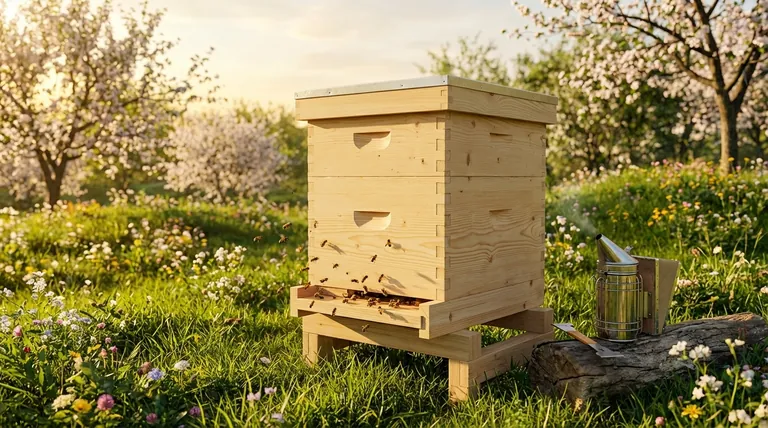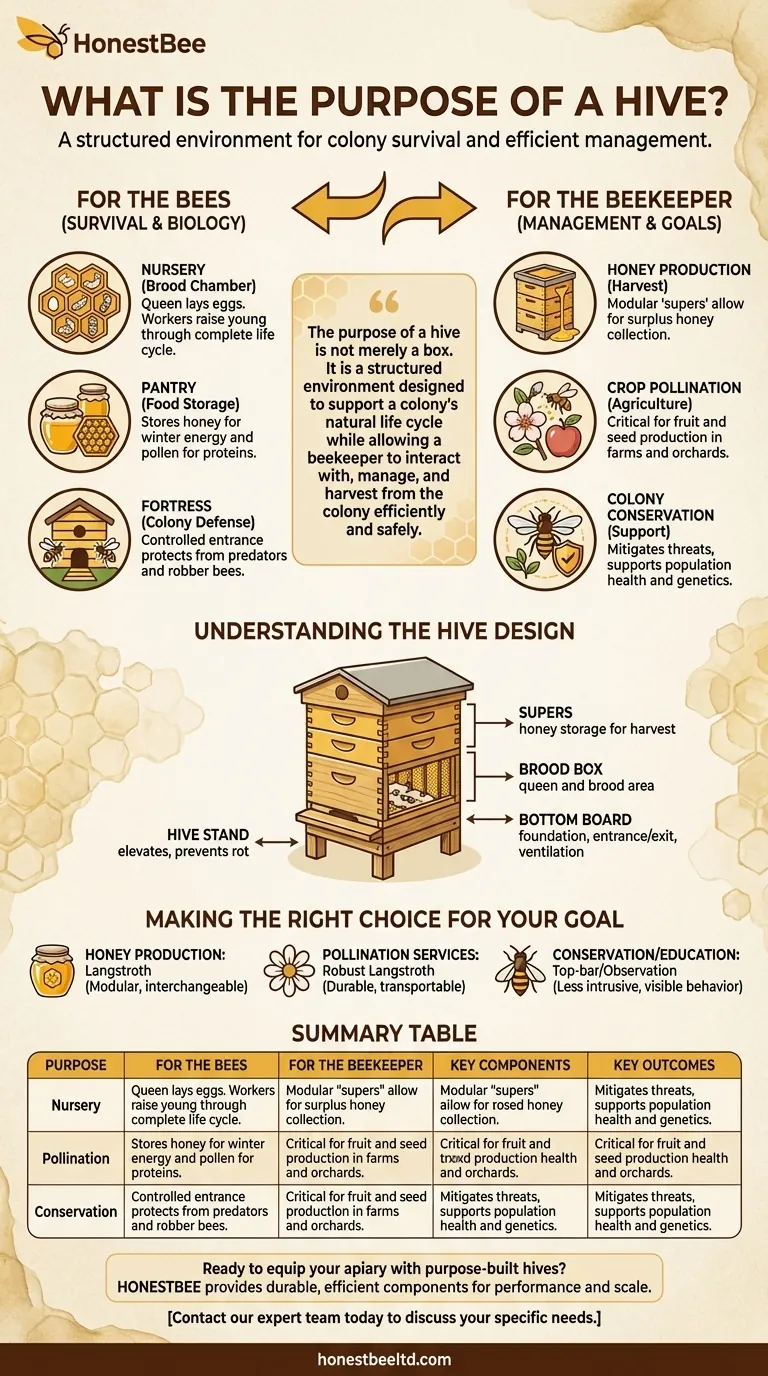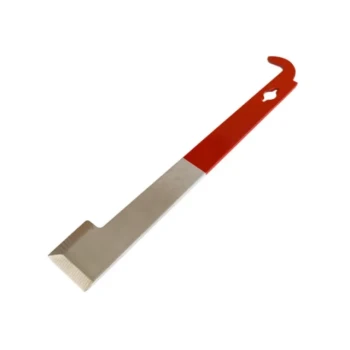At its core, a hive serves two distinct but interconnected purposes. For the bees, it is a combination of a nursery, a food pantry, and a fortress essential for their survival. For a beekeeper, it is a carefully designed tool used to manage the colony for goals like honey production, crop pollination, or conservation.
The purpose of a hive is not merely to be a box for bees. It is a structured environment designed to support a colony's natural life cycle while allowing a beekeeper to interact with, manage, and harvest from the colony efficiently and safely.

The Hive from the Bees' Perspective
A honey bee colony is a superorganism, and the hive is its body. Every component is designed to facilitate the biological imperatives of survival and reproduction.
A Nursery for the Next Generation
The central area of the hive, often called the brood chamber, is where the queen lays her eggs. Worker bees use the wax cells to raise the young through their complete life cycle: eggs, larvae, and pupae. The hive provides the stable temperature and protection necessary for this development.
A Pantry for Food Storage
Bees use other cells within the hive to store their food sources. They collect nectar and convert it into honey, a dense energy source for the winter months, and gather pollen, which provides essential proteins and nutrients for raising brood.
A Fortress for Colony Defense
The physical structure of the hive provides a defensible space. A small, controlled entrance, incorporated into the bottom board, allows guard bees to effectively protect the colony from predators and robber bees from other hives.
The Hive from the Beekeeper's Perspective
While a wild colony might live in a hollow tree, the modern beehive is a human innovation. Its design allows beekeepers to work in partnership with the bees for specific outcomes.
For Honey Production
Most beekeepers aim to harvest surplus honey. Modern hives are modular, allowing the beekeeper to add extra boxes (called "supers") for the bees to fill with honey once the needs of the brood chamber are met.
For Crop Pollination
Beekeeping is a critical component of modern agriculture. Beekeepers transport hives to farms and orchards to pollinate nearby crops, ensuring fruit and seed production for everything from almonds to apples.
For Colony Conservation
Managed hives are a tool to study and support bee populations. By providing a secure home and managing for pests and diseases, beekeepers can help mitigate the effects of threats like Colony Collapse Disorder and bolster local bee genetics.
Understanding the Design's Purpose
Each part of a managed hive has a specific function that serves both the bees and the beekeeper. Understanding these components reveals the ingenuity of the design.
The Hive Stand
A hive stand elevates the entire structure off the ground. This simple component is critical for keeping the bottom of the hive dry, which prevents rot and helps insulate the colony from the cold, damp ground.
The Bottom Board
The floorboard, or bottom board, serves as the foundation for the entire hive. Crucially, it contains the main entrance and exit for the bees, controlling traffic flow and ventilation for the whole colony.
The Brood Box and Supers
The main boxes of the hive are where the colony lives and works. The lower box(es) are typically reserved for the queen and her brood, while the upper boxes, or "supers," are designated for honey storage that the beekeeper can later harvest.
Making the Right Choice for Your Goal
The type of hive you use should align directly with your primary objective as a beekeeper.
- If your primary focus is honey production: A standard Langstroth hive is ideal due to its modularity and interchangeable parts, which simplify adding supers and harvesting honey.
- If your primary focus is pollination services: Durability and ease of transport are key, making robustly built Langstroth hives a common choice.
- If your primary focus is conservation or education: A top-bar hive or an observation hive may be preferable, as they can be less intrusive and offer a better view of the colony's natural behavior.
Ultimately, the hive is a remarkable intersection of natural biology and human engineering, designed to help a colony thrive.
Summary Table:
| Purpose | For the Bees | For the Beekeeper |
|---|---|---|
| Primary Function | Nursery, Pantry, Fortress | Honey Production, Pollination, Conservation |
| Key Components | Brood Chamber, Honey Storage, Defensible Entrance | Brood Boxes, Supers, Bottom Board |
| Key Outcomes | Colony Survival & Reproduction | Harvestable Honey, Effective Crop Pollination |
Ready to equip your apiary with purpose-built hives?
As a leading wholesale supplier to commercial apiaries and beekeeping equipment distributors, HONESTBEE provides the durable, efficient hive components and equipment you need to succeed. Whether your focus is maximizing honey yield, providing reliable pollination services, or supporting colony health, our products are designed for performance and scale.
Contact our expert team today to discuss your specific needs and discover how our wholesale solutions can help your operation thrive.
Visual Guide

Related Products
- Langstroth Bee Hives Bee Keeping Box for Beginners Beekeeping
- Australian Langstroth Beehive Boxes for Beekeeping Wholesales
- Langstroth Honey Bee Box Hive Boxes for Different Depths
- Long Langstroth Style Horizontal Top Bar Hive for Wholesale
- Professional Insulated Plastic Bee Hives
People Also Ask
- How does the ease of access differ between 8-frame and 10-frame hives? Choose the Right Hive for Your Body
- What are the different types of beehive boxes available? Choose the Right Hive for Your Apiary
- How does the orientation of the hive sides benefit comb construction? Ensure Straight, Movable Combs for Easier Hive Management
- Why might a beginner be advised to start with a Langstroth hive? Unlock a Supportive Beekeeping Ecosystem
- What are the key features of the Langstroth beehive? A Guide to the Standard for Modern Beekeeping



















